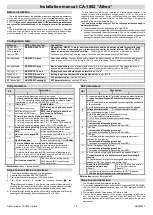
6
4.Most vehicles use a (-) negative switch, but if your does not, you will need to test for a (+) positive
door pin switch.
5.Connect your meter or test light's negative lead to a good solid chassis ground. Use the positive lead
or other lead probe to the door pin switch wire. Then open the door. If the test light turns on or the
volt meter indicates 12 volts, your vehicle has a (+) positive switch door pin.
6.If your door pin switch tests as a (+) positive, connect the BLACK WITH BLUE STIPE wire from the main
harness to this wire.NOTE: The door inputs activate 20 seconds after arming. Door switch testing should
take place only after 20 seconds have elapsed after arming. Some vehicles such as HONDA have door switch
isolation diodes on each door. These vehicles must be wired at the wire that triggers the dome light
circuit after the diodes. If the door switch wires are difficult to reach, connect the input wire to
the dome light itself. Tape up the unused wire.
INSTALLING THE FLASHING LED STATUS INDICATOR
The LED indicator installs inside your vehicle and should be installed
as high as possible and be visible from all windows. Drill a 1/4"
mounting hole in the dash panel or use the supplied mounting bracket.
CONNECTING THE LED STATUS INDICATOR
Insert the blue plug of the LED status indicator into the
blue plug next to the main connector. TEST: Press transmitter
Button #1, the LED should flash.
MOUNTING AND CONNECTING THE OVERRIDE SWITCH
Select a location for the override switch. You should be able to reach the switch when sitting in the
driver's seat, but the switch should be hard to find. A typical mounting location is under the dash.
The mounting surface should be less than 1/8" thick.
1.Drill a 5/16" hole in the mounting surface, taking care not to damage anything behind the surface.
2.Remove the switch's top nut and lock washer.
3.Push the switch into the hole from the back of the mounting surface. Then secure it with the lock
washer and nut.
4.Connect the ground wire to a metal vehicle body part using an existing screw.
5.Override Switch - Plug override switch into the white plug next to the main connector. TEST: Violate
any zone on the alarm causing the siren to sound. Open the vehicle door, place ignition key to "ON"
position, then press the override switch. The siren should silence and you will now be able to start
the engine. NOTE: A door must remain open during this procedure.
MOUNTING AND CONNECTING THE ANTI-CARJACKING SWITCH
Select a location for the anti-carjacking switch. You should be able to reach the switch when sitting
in the driver's seat, but the switch should be hard to find. A typical mounting location is under the
dash, the mounting surface should be less than 1/8" thick.
1.Drill a 1/4" hole in the mounting surface, taking care not to damage anything behind the surface.
2.Remove the switch's top nut and lock washer.
3.Push the switch into the hole from the back of the mounting surface. Align the switch so ON is away
from the driver. Then secure it with the lock washer and nut.
4.Connect the ground with to a metal vehicle body part using an existing screw. TEST: Close all the doors,
flip the toggle switch to the ON or forward position and start the vehicle. Open and close a door and
wait one minute, the siren will sound. When the siren sounds, turn off the engine and then try to restart
it. The engine should not start. To return the system to normal operation, turn off the ignition switch,
flip the toggle switch to OFF or to the rear and press transmitter Button #1. The siren should stop
and you will now be able to start the engine.
CONNECTING ADDITIONAL SENSORS (Optional)
Follow the instructions that come with the sensor to mount and power it. The system requires a negative
(-) output on the accessory for activation of the alarm.
If the sensor has a single alarm output, connect it to either the main wiring harness's yellow wire to
have the sensor trigger the alarm or to the harness's green wire to have the sensor trigger only warning
chirps. If the sensor has both warning and alert triggers, connect the warning trigger to the harness's
GREEN wire and the alert trigger to the harness's YELLOW wire CAUTION: When adding more than one shock
sensor or perimeter sensor on the same input trip, you must add a 1 amp diode to the output of each
sensor.
LED
INDICATOR
GROUND
OVERRIDE
SWITCH
WHITE PLUG
ON THE LEFT
OF MODULE
:
:
ANTI-CARJACKING
SWITCH
BLUE PLUG
MAIN CONNECTOR






























